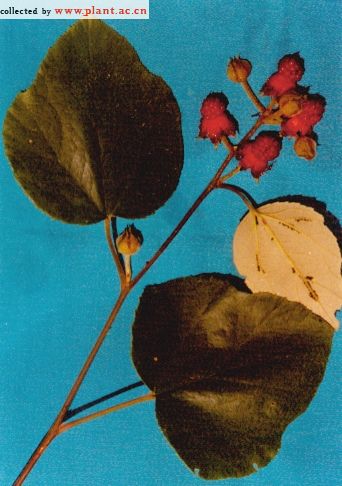灰毛泡Rubus irenaeus Focke
灰毛泡Rubus irenaeus Focke
147. 灰毛泡(中国高等植物图鉴) 地五泡藤(经济植物手册)
Rubus irenaeus Focke in Engler, Bot. Jahrb 29:394. 1901; id. Bibl. Bot. 72(1):114. f. 52. 1910 et 83:35. 1914; Card. In Bull. Mus. Hist. Nat. Paris 23:289. 1917; Hand.-Mazz. Symb. Sin. 7:497. 1933; Rehd. In Journ. Arn. Arb. 18:36. 1937; 中国高等植物图鉴 2:268. 图 2265. 1972. ——R. jamini Levl. et Vant. in Bull. Acad. Geog. Bot. 11:102. 1902 et 12:160. f. 7. 1903; Focke, Bibl. Bot. 72(1):114. 1910.
种中文名:灰毛泡
种拉丁名:Rubus irenaeus Focke
种别名 :地五泡藤
国内分布:赣,湘,鄂,浙,苏,闽,粤,桂,川,黔
海 拔:500-1300
命名来源:[Botanische Jahrbucher fur Systematik, Pflanzengeschichte und Pflanzengeographie 29(3-4): 394-395 1900]
中国植物志:37:181
英文植物志:9:268
亚组中文名:锈叶亚组
亚组拉丁名:Subsect.Fuscifolii
组中文名:木莓组
组拉丁名:Sect.Malachobatus Fockc in
属中文名:悬钩子属
属拉丁名:Rubus
亚科中文名:蔷薇亚科
亚科拉丁名:ROSOideae Pocke
科中文名:蔷薇科
科拉丁名:Rosaceae
纲中文名:双子叶植物纲
纲拉丁名:DICOTYLEDONEAE
门中文名:被子植物门
门拉丁名:ANGIOSPERMAE
参考文献:Rutbus irenaeus Focke in Engler,Bot.Jahrb 29t394。1901“d.BiN.Bot.72(”: 114.F.52. 1910 ct 83:3S.1914;Card.In Bull,Mus.,Hist,;Nat.Paris 23:289.19l?; Hand.-Mazz.Symb;Sin,7:497.1933;Rehd.In Journ.Arn. Arb。;18:36.1937;·中国高 等植物图鉴2:268.图2265. 1972.: - R.jamini Levl,et·Vant.In Bull.Acad.Cdog· Bot.11:102.1902 ct 12:160.F.7.1903;·,Focke,:Bibl.Bot.72(1):114.,1910..
亚组概述:Subsect.Fuscifolii Y6 et Lu,植物分类学报20(4):458.1982——Sect.Moluccani Focke,Bibl.Bot.?2(1):71.1910 et 83:28.1914·p.P. 本亚组有下列7种。
《Flora of China》 Vol. 9 (2003)
Rubus irenaeus Focke
灰毛泡 hui mao pao
Shrubs 0.5–2 m tall, evergreen. Branchlets brownish, reddish brown, or grayish brown, densely gray tomentose-villous; flowering branches arising from rhizomes, sometimes with small prickles. Leaves alternate, simple; petiole 5–10 cm, densely tomentose-villous, unarmed or with sparse, small prickles; stipules leaflike, brownish, oblong, 2–3 × 1–2 cm, tomentose-villous, broader and incised-laciniate near apex; lobes lanceolate; blade suborbicular, 8–14 cm in diam., palmately 5-veined, veins yellowish brown and prominently raised abaxially, impressed adaxially, subleathery, abaxially densely gray or yellowish gray tomentose, with long hairs along veins, adaxially glabrous, base deeply cordate, margin undulate or lobed; lobes unevenly coarsely sharply serrate, apex obtuse or acute. Inflorescences terminal, corymbs or subracemes, (3–)4–6 cm, few flowered, sometimes flowers several in clusters or flowers solitary in leaf axils; rachis and pedicels densely tomentose-villous; bracts oblong, 1.5–2.5 × 1–1.5 cm, tomentose, margin or apex incised-laciniate. Pedicel 1–1.5 cm. Flowers 1.5–2 cm in diam. Calyx abaxially densely tomentose-villous; sepals reflexed in fruit, broadly ovate, 6–10 × (4–)5–7 mm, apex shortly acuminate; outer sepals with margin and apex laciniate; lobes linear-lanceolate, inner sepals entire. Petals white, suborbicular, 7–11 mm in diam., slightly longer than sepals, base clawed. Stamens many, shorter than petals; filaments linear, with slightly broad bases; anthers villous. Pistils 30–60, longer than stamens, glabrous. Aggregate fruit red, globose, 1–1.5 cm in diam., glabrous; pyrenes reticulate. Fl. May–Jun, fr. Aug–Sep.
Forests, slopes, forest understories with rich humus; 500--1500 m. Chongqing, Fujian, Guangdong, Guangxi, Guizhou, Hubei, Hunan, Jiangsu, Jiangxi, Sichuan, Yunnan, Zhejiang.
The fresh fruit are used for jam, candy, drinks, and wine. The roots and young plants are used in traditional Chinese medicine.
别名:地五泡藤;灰毛藨;包谷泡;地棠泡;地玉泡;灰毛莓;地五泡芚;乌泡倒触生;美丽悬钩子;灰毛泡藤;三月泡;
科名:蔷薇科 Rosaceae
属名:悬钩子属 Rubus

147. 灰毛泡(中国高等植物图鉴) 地五泡藤(经济植物手册)
Rubus irenaeus Focke in Engler, Bot. Jahrb 29:394. 1901; id. Bibl. Bot. 72(1):114. f. 52. 1910 et 83:35. 1914; Card. In Bull. Mus. Hist. Nat. Paris 23:289. 1917; Hand.-Mazz. Symb. Sin. 7:497. 1933; Rehd. In Journ. Arn. Arb. 18:36. 1937; 中国高等植物图鉴 2:268. 图 2265. 1972. ——R. jamini Levl. et Vant. in Bull. Acad. Geog. Bot. 11:102. 1902 et 12:160. f. 7. 1903; Focke, Bibl. Bot. 72(1):114. 1910.
种中文名:灰毛泡
种拉丁名:Rubus irenaeus Focke
种别名 :地五泡藤
国内分布:赣,湘,鄂,浙,苏,闽,粤,桂,川,黔
海 拔:500-1300
命名来源:[Botanische Jahrbucher fur Systematik, Pflanzengeschichte und Pflanzengeographie 29(3-4): 394-395 1900]
中国植物志:37:181
英文植物志:9:268
亚组中文名:锈叶亚组
亚组拉丁名:Subsect.Fuscifolii
组中文名:木莓组
组拉丁名:Sect.Malachobatus Fockc in
属中文名:悬钩子属
属拉丁名:Rubus
亚科中文名:蔷薇亚科
亚科拉丁名:ROSOideae Pocke
科中文名:蔷薇科
科拉丁名:Rosaceae
纲中文名:双子叶植物纲
纲拉丁名:DICOTYLEDONEAE
门中文名:被子植物门
门拉丁名:ANGIOSPERMAE
参考文献:Rutbus irenaeus Focke in Engler,Bot.Jahrb 29t394。1901“d.BiN.Bot.72(”: 114.F.52. 1910 ct 83:3S.1914;Card.In Bull,Mus.,Hist,;Nat.Paris 23:289.19l?; Hand.-Mazz.Symb;Sin,7:497.1933;Rehd.In Journ.Arn. Arb。;18:36.1937;·中国高 等植物图鉴2:268.图2265. 1972.: - R.jamini Levl,et·Vant.In Bull.Acad.Cdog· Bot.11:102.1902 ct 12:160.F.7.1903;·,Focke,:Bibl.Bot.72(1):114.,1910..
亚组概述:Subsect.Fuscifolii Y6 et Lu,植物分类学报20(4):458.1982——Sect.Moluccani Focke,Bibl.Bot.?2(1):71.1910 et 83:28.1914·p.P. 本亚组有下列7种。
《Flora of China》 Vol. 9 (2003)
Rubus irenaeus Focke
灰毛泡 hui mao pao
Shrubs 0.5–2 m tall, evergreen. Branchlets brownish, reddish brown, or grayish brown, densely gray tomentose-villous; flowering branches arising from rhizomes, sometimes with small prickles. Leaves alternate, simple; petiole 5–10 cm, densely tomentose-villous, unarmed or with sparse, small prickles; stipules leaflike, brownish, oblong, 2–3 × 1–2 cm, tomentose-villous, broader and incised-laciniate near apex; lobes lanceolate; blade suborbicular, 8–14 cm in diam., palmately 5-veined, veins yellowish brown and prominently raised abaxially, impressed adaxially, subleathery, abaxially densely gray or yellowish gray tomentose, with long hairs along veins, adaxially glabrous, base deeply cordate, margin undulate or lobed; lobes unevenly coarsely sharply serrate, apex obtuse or acute. Inflorescences terminal, corymbs or subracemes, (3–)4–6 cm, few flowered, sometimes flowers several in clusters or flowers solitary in leaf axils; rachis and pedicels densely tomentose-villous; bracts oblong, 1.5–2.5 × 1–1.5 cm, tomentose, margin or apex incised-laciniate. Pedicel 1–1.5 cm. Flowers 1.5–2 cm in diam. Calyx abaxially densely tomentose-villous; sepals reflexed in fruit, broadly ovate, 6–10 × (4–)5–7 mm, apex shortly acuminate; outer sepals with margin and apex laciniate; lobes linear-lanceolate, inner sepals entire. Petals white, suborbicular, 7–11 mm in diam., slightly longer than sepals, base clawed. Stamens many, shorter than petals; filaments linear, with slightly broad bases; anthers villous. Pistils 30–60, longer than stamens, glabrous. Aggregate fruit red, globose, 1–1.5 cm in diam., glabrous; pyrenes reticulate. Fl. May–Jun, fr. Aug–Sep.
Forests, slopes, forest understories with rich humus; 500--1500 m. Chongqing, Fujian, Guangdong, Guangxi, Guizhou, Hubei, Hunan, Jiangsu, Jiangxi, Sichuan, Yunnan, Zhejiang.
The fresh fruit are used for jam, candy, drinks, and wine. The roots and young plants are used in traditional Chinese medicine.

